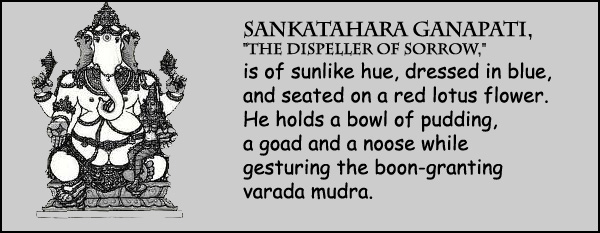Ganesha's Moon: First 4th Waning Moon of 2015.
Your emotional make-up, unconscious habits, rhythms and memories are all associated with the Moon. When the Moon is waning, it's getting darker. The waning moon supports being more inward and reflective.The 4th Waning Moon has a special relationship with the Obstacle-Removing Archetype, Lord Ganesha. This creates an ideal window of time to smash through obstacles in your life. The 4th Moon is a Moon of destruction and Ganesha uses this power of destruction to destroy obstacles.

Astrology behind Ganesha's 4th Waning Moon
 The upcoming 4th waning Moon on Thursday, January 8th is very significant. The Moon will be in the star of Magha. The star Magha is ruled by Ketu and Lord Ganesha is the overlord of the planet Ketu. The planet Ketu in astrology is said to bring in obstacles and also on the other side confer victory. The day beingThursday is ruled by Jupiter, thus strongly connecting Ketu, the Moon and Jupiter. Propitiating Lord Ganesha on this 4th Waning Moon, clears obstacles to wealth and creates a space for miracles to occur in your life. It activates your Miracle brain (the Midbrain) which will also increase your all important intuitive intelligence.
The upcoming 4th waning Moon on Thursday, January 8th is very significant. The Moon will be in the star of Magha. The star Magha is ruled by Ketu and Lord Ganesha is the overlord of the planet Ketu. The planet Ketu in astrology is said to bring in obstacles and also on the other side confer victory. The day beingThursday is ruled by Jupiter, thus strongly connecting Ketu, the Moon and Jupiter. Propitiating Lord Ganesha on this 4th Waning Moon, clears obstacles to wealth and creates a space for miracles to occur in your life. It activates your Miracle brain (the Midbrain) which will also increase your all important intuitive intelligence.
 How to observe Sankatahara Chaturthi fasting Why fast on Sankatahara Chaturthi ? Fasting on Sankatahara Chaturthi is considered very auspicious and extremely beneficial. Usually it is recommended to take up this vratam for a period of One year and observe fasting on all the Sankatahara Chaturthi days and will end it by performing "Maha Ganapathi Homam" or "Vaancha Kalpa Ganapathy Homan".By doing this, it is believed that all the difficult tasks will be accomplished and the obstacles will be removed from one's life. How to observe fast on Sankatahara Chaturthi : Fasting procedure: The devotees should observe Sankatahara Chaturthi by having a complete fast which will be broken after observing the moon rise, followed by a puja to Lord Ganesha. Some devotees go for partial fast. If you observe partial fast you can eat fruits or Sabudhana Khichadi during brunch breaks. Partial fasting is recommended for people who are employed, since it will be difficult to observe complete fasting without feeling exhausted in your work. Chaturthi Morning Prayers : Take bath early in the morning and offer a simple prayer to Lord Ganesha by chanting one of his famous Ganesha slokas (vakrathunda mahakaya.. surya kodi samaprabha..). Light a lamp with Ghee. Beginners can consider reciting the 108 names of Ganesha instead of complex slokas, which may discourage you from continuing the fasting. Starting with light and easy slokas in the beginning and proceeding into complex slokas is a practical method to cultivate the habit of vratam. Evening Prayers : The evening puja is performed after the sunset and when you can witness the moon (if you can ) as at times it becomes tricky to spot the moon, if the sky is clouded. So some refer to Almanac or Panchang to know the Moon-rise time for that particular day. But reading an almanac (panchang) requires some practice and it will be overwhelming for a beginner. So if you are just beginning to observe this fast, perform your evening puja approximately around 7.30pm. After seeing the moon, do a quick chanting of Ganesh Slokas similar to your morning prayers. Pray to a photo or statue of Lord Ganesh in your puja room.Or make a ganapathy pyramid (ganapathy cone) out of turmeric powder everyday and praying to that more serene & auspicious. If you are performing this vrata for the good of your loved ones, it is recommended that you offer the coconut or banana or milk as prasadham to them and other family members. Symbolically consuming a prasadham from a puja is considered essential to complete one's prayers. It is also viewed as divine blessings from Ganesha.  |

No comments:
Post a Comment